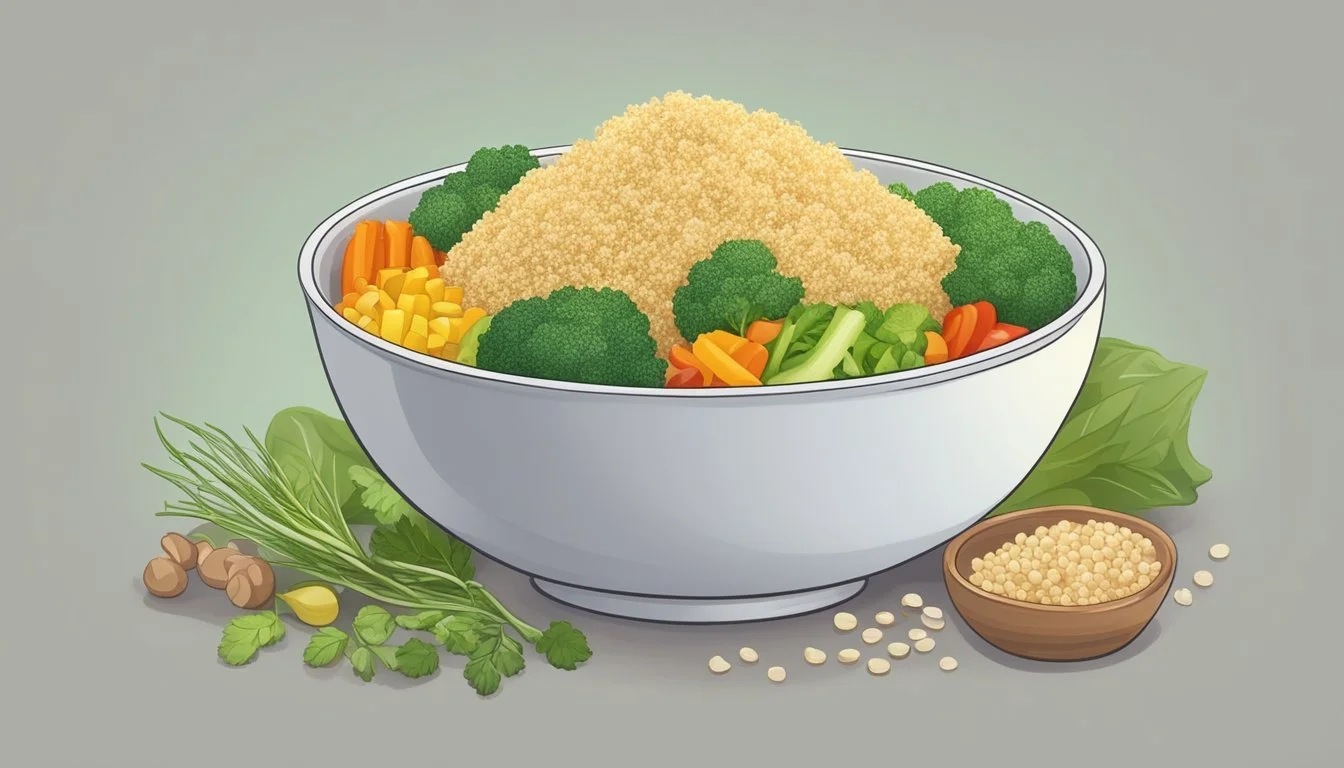How to Reheat Gluten-Free Quinoa Bowls for Maximum Flavor and Texture
Reheating gluten-free quinoa bowls can be a bit tricky, but it's essential for maintaining their delicious flavor and texture. Quinoa, a healthy grain rich in protein and fiber, is a perfect choice for meal prep enthusiasts aiming for nutritious and easy-to-reheat meals. To reheat quinoa bowls efficiently, it's crucial to preserve moisture and prevent the quinoa from drying out.
Using a microwave-safe bowl, place the quinoa and break up any clumps with a fork. Cover the bowl with a damp paper towel and microwave on high for 30-60 seconds, depending on whether the quinoa is fresh or frozen. Alternatively, you can reheat quinoa on the stovetop or in the oven by using a low to medium heat setting and covering the pot or dish to trap steam and maintain moisture.
For those who appreciate variety, reheating on a stovetop offers a chance to enhance the dish by adding some fresh vegetables or a splash of broth for added flavor. Whichever method you choose, reheating your quinoa bowls correctly will ensure a tasty, nutritious meal every time.
Benefits of Gluten-Free Quinoa
Quinoa is a versatile grain that offers numerous health benefits and is ideal for those following a gluten-free diet. It is rich in essential nutrients such as protein, fiber, iron, potassium, and various vitamins, making it a highly nutritious option.
Nutritional Profile of Quinoa
Quinoa is particularly noted for its high protein content. Unlike most plant-based foods, it contains all nine essential amino acids, making it a complete protein source. This is especially beneficial for vegans and vegetarians.
Fiber content in quinoa is substantial, aiding in digestion and promoting a feeling of fullness. Each serving provides 7% dietary fiber.
In addition to these, quinoa is a good source of iron, which is crucial for transporting oxygen in the blood, and potassium, which helps maintain electrolyte balance.
The carbohydrate content in quinoa is around 64.2%, providing a steady source of energy. Despite being carbohydrate-rich, quinoa has a favorable glycemic index, making it suitable for blood sugar management.
Key Nutritional Facts
Nutrient Amount per 100g Protein 14.1% Fiber 7% Iron Present Potassium Present Carbohydrates 64.2% Calories Moderate
Whole grain quinoa also offers antioxidants and other micronutrients, contributing to its status as a superfood. It's versatile and easily incorporated into various gluten-free recipes, enhancing both flavor and nutritional value.
By focusing on quinoa’s nutritional benefits, it's clear why it stands out as a staple in a health-conscious, gluten-free diet.
Selecting Ingredients for Your Quinoa Bowl
Crafting a flavorful and nutritious quinoa bowl starts with selecting the best ingredients. The right quinoa, vegetables, and proteins can elevate the dish, catering to various dietary preferences including vegan and gluten-free options.
Choosing the Right Quinoa
Quinoa varieties include white, red, and black quinoa, each with distinct textures and flavors. White quinoa is soft and fluffy, best for light salads. Red and black quinoa, with a crunchier texture, works well in heartier dishes.
Pre-rinsed quinoa saves preparation time. If not pre-rinsed, rinse thoroughly to remove the bitter coating known as saponin. Use a fine-mesh strainer for best results.
Cooking the quinoa properly is essential. Combine one part quinoa with two parts water in a pot. Bring to a boil, then simmer covered for 15-20 minutes until water is absorbed. Fluff with a fork and let it rest.
Accompanying Vegetables and Proteins
Vegetables add color and nutrients. Tomatoes, cucumbers, avocado, and sweet potatoes are popular choices. Green veggies like broccoli, spinach, and kale provide added fiber and vitamins.
Proteins can be tailored to dietary needs. Grilled chicken, steak, and eggs offer high-protein options for non-vegans. Tofu, beans, and chickpeas provide plant-based protein.
Flavor boosters like onion and red onion enhance taste. Roasted sweet potatoes can add a caramelized sweetness. Fresh herbs and spices like onion powder and garlic powder can elevate flavor profiles. Olives and a drizzle of olive oil can also add depth to the dish.
Mix and match various ingredients to create a balanced, flavorful bowl. With the right selection of quinoa, vegetables, and proteins, each bowl will be both nutritious and satisfying.
Preparing Your Gluten-Free Quinoa Bowl
To create a delicious and healthy gluten-free quinoa bowl, focus on cooking the quinoa perfectly, sautéing vibrant vegetables, and selecting your preferred protein sources.
Cooking Quinoa
Begin by rinsing 1 cup of quinoa under cold water to remove its natural coating, which can make it taste bitter. In a saucepan, bring 2 cups of water to a boil. Add a pinch of salt, then add the rinsed quinoa. Reduce the heat to low, cover the pot, and simmer for about 15 minutes until all the water is absorbed. Once done, let the quinoa sit for 5 minutes, then fluff it with a fork.
Sautéing Vegetables
Choose fresh vegetables like broccoli, kale, or bell peppers. Heat 1-2 tablespoons of olive oil in a pan over medium heat. Add minced garlic and cook until fragrant. Add the vegetables, season with salt and black pepper, and sauté until tender but still crisp, about 5-7 minutes. For added flavor, you can include a splash of lemon juice or a pinch of your favorite herbs.
Adding Proteins
Protein options can include grilled chicken, chickpeas, scrambled eggs, tofu, or fish like salmon or walleye. Season your chosen protein with salt and black pepper. Cook chicken, tofu, or fish in a lightly oiled pan until fully done. Alternatively, roasted chickpeas can add a crunchy texture. Eggs can be scrambled or poached for a softer addition. Combine the protein with the quinoa and veggies for a balanced meal.
Customizing the Flavor Profile
Enhancing the taste of gluten-free quinoa bowls can be achieved by experimenting with various spices, herbs, and homemade dressings or sauces. This customization ensures each meal is uniquely delicious and caters to personal preferences.
Experimenting with Spices and Herbs
Using spices and herbs is an excellent way to elevate the flavor of quinoa bowls. Ground black pepper, sea salt, and cayenne pepper are classic choices that add a subtle kick.
Adding fresh herbs like cilantro or parsley brings a bright and fresh taste. Cilantro pairs well with lemon-based dressings, whereas parsley complements tomato and cucumber toppings. Garlic powder and onion powder can also be added for deeper, savory notes.
Homemade Dressings and Sauces
Homemade dressings and sauces can transform a simple quinoa bowl. A tahini dressing made from tahini, lemon juice, and a touch of maple syrup offers a creamy, nutty flavor.
For a Mediterranean twist, a dressing composed of olive oil, lemon juice, and minced garlic works perfectly. Balsamic glaze can be drizzled over for a hint of sweetness and acidity. Hot pepper sauce can add an extra layer of spice for those who like it hot.
Reheating and Serving Quinoa Bowls
Reheating gluten-free quinoa bowls correctly ensures that the texture and nutrition remain intact. The methods for reheating include using the microwave, oven, and stovetop, each suited for different situations.
Best Practices for Reheating
Microwave: Place the quinoa bowl in a microwave-safe dish. Cover with a damp paper towel. Heat on full power for 30-60 seconds, stirring every 15 seconds to evenly distribute the heat.
Oven: Preheat the oven to 350°F. Transfer quinoa to an oven-safe dish and cover with foil. Bake for 15-20 minutes or until warm. Stir midway to ensure consistent temperature.
Stovetop: Heat a non-stick pan over medium heat. Add a splash of water or broth to the quinoa and stir until heated through. This method helps maintain moisture and prevents drying.
Maintaining Texture and Nutrition
Texture: Rehydrating quinoa before reheating can help retain its fluffy texture. Adding a small amount of liquid, like water or broth, prevents dryness and enhances the flavor.
Nutrition: Avoid overheating to preserve nutrients. Microwaving for short bursts and frequent stirring can help maintain the quinoa's nutritional profile. Adding fresh ingredients post-reheat, such as chopped vegetables or herbs, can boost both nutrition and texture.
Keeping these tips in mind can make reheating gluten-free quinoa bowls easy and effective. The key is to use the correct reheating method and maintain the right moisture levels to ensure both flavor and nutrition are preserved.
Creative Variations for Next-Day Meals
Next-day quinoa bowls provide a versatile foundation for a range of meals. Transform these bowls into unique dishes or incorporate them seamlessly into breakfast, lunch, and dinner menus.
Transforming Quinoa Bowls into New Dishes
Reimagining quinoa bowls allows for exciting and varied dishes. Quinoa Patties are a popular choice; mix the leftover quinoa with eggs, chopped vegetables, and spices. Form into patties and pan-fry until golden brown.
Quinoa Stuffed Peppers offer another option. Hollow out bell peppers and fill with the quinoa mixture. Bake until peppers are tender and the stuffing is heated through.
For a quick and light alternative, consider a Quinoa Salad. Add fresh vegetables, a handful of nuts, and a drizzle of vinaigrette for a refreshing meal.
Quinoa for Breakfast, Lunch, and Dinner
Quinoa's adaptability shines in meals throughout the day. Start with a Breakfast Quinoa Bowl by warming the quinoa and topping it with fruits, nuts, and a splash of almond milk.
At lunch, try a Quinoa Wrap. Spread a tortilla with hummus, layer with quinoa, fresh vegetables, and roll tightly.
For dinner, a Quinoa Bowl Stir-Fry is an option. Sauté vegetables and any leftover protein with cooked quinoa. Season with soy sauce and sesame oil for a flavorful and nutritious dish.
Using quinoa in various meals ensures that leftovers never become monotonous while offering balanced nutrition and delicious flavors.
Additional Tips for Gluten-Free Quinoa Bowls
To get the best out of your gluten-free quinoa bowls, proper storage and adherence to gluten-free standards are essential. These tips will help maintain quality and safety.
Storage and Meal Prep
Meal Prep:
For quick and easy, healthy bowls throughout the week, prepare several portions of cooked quinoa in advance. Store in airtight containers to keep them fresh. Include variety by preparing different toppings and storing them separately.
Reheat quinoa in the microwave by covering it with a damp paper towel to maintain moisture. Set the timer for 30-60 seconds, checking and stirring halfway through for even heating.
Freezing:
Quinoa freezes well. Divide into portions, store in freezer-safe bags, and label with dates. Reheat directly from frozen for convenience.
Avoiding Sogginess:
Fluff cooked quinoa with a fork before storing. This prevents clumping and maintains the bowl's texture.
Ensuring Gluten-Free Standards
Ingredient Check:
Always check labels for gluten-free certification. Even naturally gluten-free ingredients like quinoa can be cross-contaminated during processing.
Use dedicated utensils and cookware to avoid cross-contact with gluten-containing foods. This is crucial for maintaining strict gluten-free standards.
Certified Brands:
Opt for brands that specifically label their products as gluten-free. This ensures additional levels of precaution have been taken.
Dining Out:
When eating out, ensure the restaurant understands the gluten-free requirements. Ask about their preparation process to avoid unintentional contamination.
Bulk Purchase:
Buying gluten-free ingredients in bulk can save money, but be wary of bulk bins that may lead to cross-contact. It's safer to buy pre-packaged, certified items.








